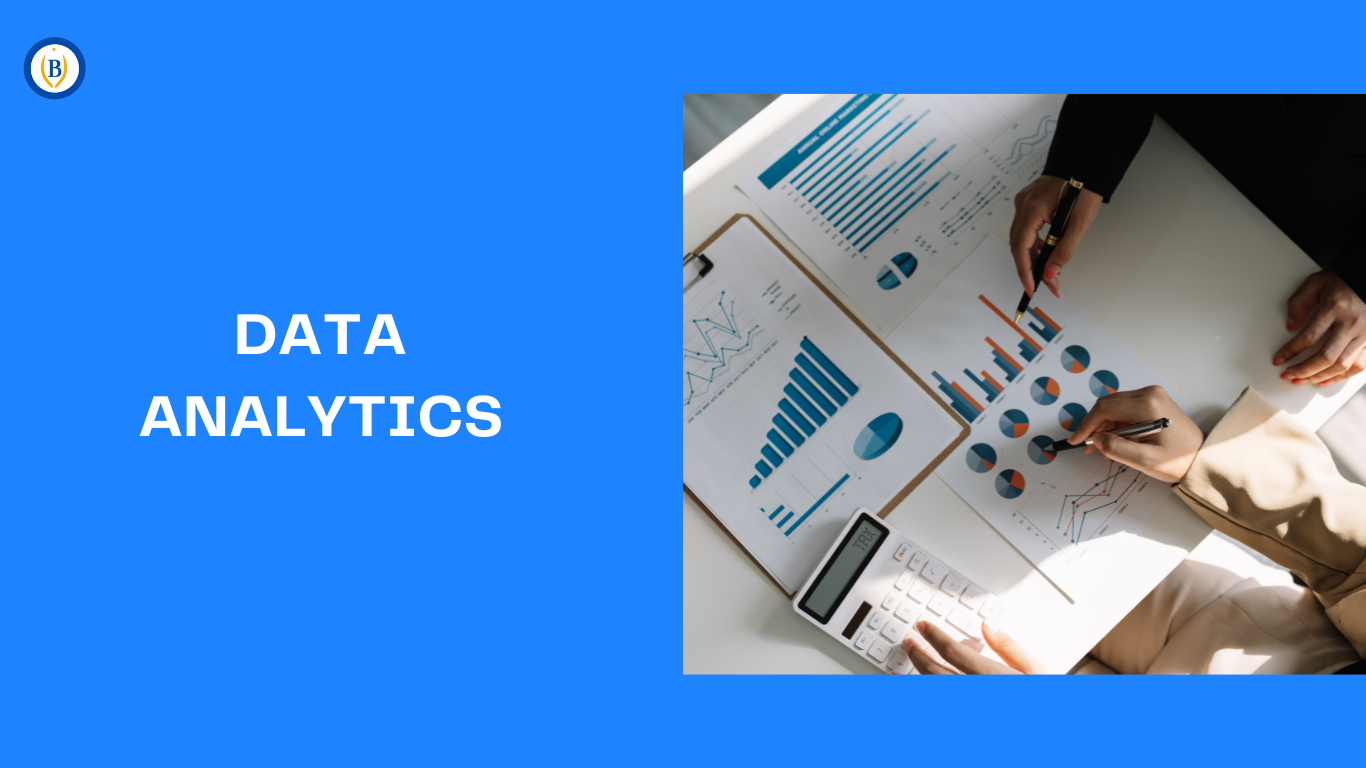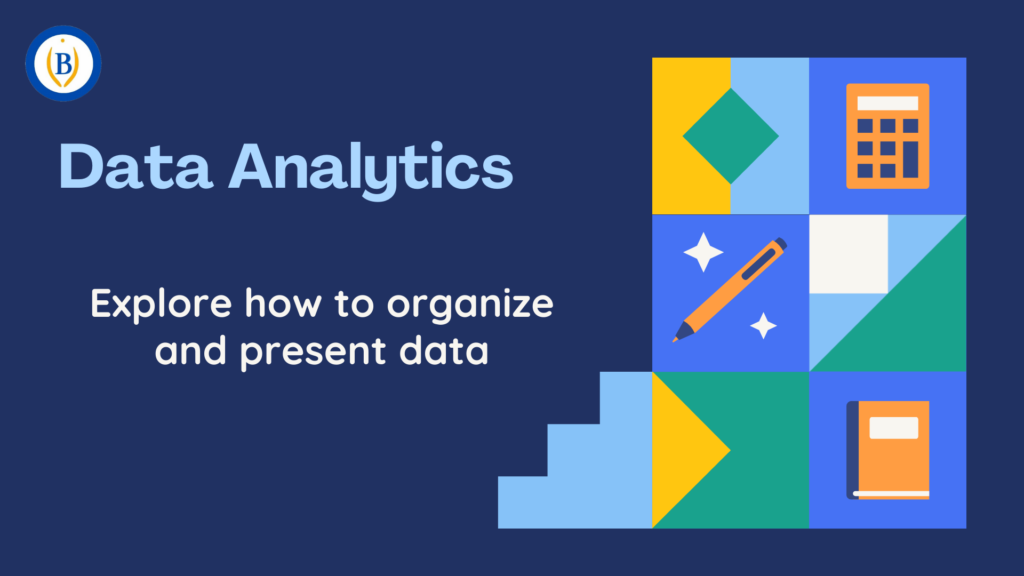Data Analytics
The process of gathering, analyzing, and interpreting data in order to gain knowledge and support decision-making is known as data analytics, and it is a significant field. The process of looking at unprocessed data to find patterns, make inferences, and extract valuable information is called data analytics. To process and convert data into insightful knowledge that can be applied to decision-making, a variety of methods and instruments are employed.
We will learn about data analytics, types of data analytics, techniques, tools, and the significance of data analytics in this section. Data analytics can assist individuals and businesses in improving and solving complex problems.

What is Data Analytics?
There are new concepts emerging as a result of the massive amount of data generated in this age of technology. We can utilize this data to support us in making data-driven decisions because we have a lot of processing power and data. Observing historical trends that have produced positive outcomes is the primary source of advantage when making judgments based on data.
Uses of Data Analytics?
Data analytics plays a crucial role in today’s business landscape, offering numerous benefits across various industries. Here are some key uses of data analytics:
- Generating Informed Decisions: By examining historical and current data trends, data analytics assists organizations in making well-informed decisions. Businesses can discover new possibilities and optimize strategy by having a thorough understanding of internal processes, market dynamics, and customer behavior.
- Increased Productivity and Efficiency: Organizations can find process bottlenecks and inefficiencies by examining operational data. They are able to improve overall productivity, optimize operations, and allocate resources more wisely as a result.
- Enhanced Customer Insights: Businesses can learn more about the preferences, needs, and behaviours of their customers thanks to data analytics. Organizations can improve customer connections, enhance customer service, and personalize marketing campaigns by evaluating customer data from several sources.
- Predictive analytics: By using past data patterns, data analytics enables organizations to project future trends and results. Models for predictive analytics can forecast demand from customers, spot possible hazards, and direct strategic planning to reduce uncertainty.
- Risk management: Organizations can identify and reduce a variety of risks through analyzing data pertaining to financial transactions, market circumstances, and operational procedures. Fraud detection, regulatory compliance, and anomaly identification are all made possible with the aid of data analytics.
- Optimized Marketing Campaigns: Companies may assess a marketing campaign’s efficacy in real time thanks to data analytics. Through surveillance of data like click-through rates, conversion rates, and customer engagement, companies may enhance their marketing strategy to effectively target the appropriate audience with relevant content.
- Cost reduction: Organizations can achieve significant cost reductions across a range of operations by utilizing data analytics to optimize resource allocation, streamline processes, and find cost-saving opportunities.
- Better Product Development: Information from data analytics about market trends, competitive tactics, and consumer preferences can help with product development. Organizations can better meet market demand and spur innovation by developing goods that are informed by client wants and preferences.

Essential Features of Data Analytics?
The goal of data analytics is to derive valuable insights from unstructured data using a wide variety of features and capabilities. Here are some key features of data analytics:
Data Gathering:
- It includes gathering information from a variety of sources, including files, databases, sensors, social media, and other platforms.
- Information can be either unstructured (text documents, photos, and videos) or structured (relational databases).
- Web scraping, APIs, surveys, Internet of Things devices, and manual entry are some procedures used to gather data.
Preprocessing & Data Cleaning:
- Refers to the procedure that organizes, transforms, and cleans raw data in order to get it ready for analysis.
- Missing value management, duplicate elimination, format standardization, and error correction are among the tasks.
- Outlier identification, feature scaling, and normalizing are a few examples of preprocessing procedures.
Data Visualization and Exploration:
- Utilizing statistical techniques and visual aids to analyze data in order to find patterns, trends, and linkages.
- Heatmaps, scatter plots, histograms, summary statistics, and interactive dashboards are some of the techniques used.
- Tools for visual analysis and communication like Tableau, Power BI, and Matplotlib make it easier to explore and share insights.
Investigating and Visualizing Data:
- Using statistical techniques and visual aids to analyze data in order to find correlations, patterns, and trends.
- Histograms, scatter plots, heatmaps, interactive dashboards, and summary statistics are some of the techniques used.
- The examination and sharing of insights are made easier by visualization tools like Tableau, Power BI, and Matplotlib.
Big Data Encoding:
- Handles data that is larger than what conventional database systems can hold, both structured and unstructured.
- Processes and Analyzes data concurrently across server clusters using distributed computing frameworks like as Hadoop, Spark, and Apache Flink.
- Permits the efficient processing and storing of large datasets at a low cost, together with scalability and fault tolerance.
Privacy and Data Security:
- Guarantees the availability, confidentiality, and integrity of data during the analytics process.
- Entails data anonymization, access control, encryption, and adherence to laws like HIPAA and GDPR.
- Shields private data from misuse, unlawful access, and breaches.
Scalability and Efficiency:
- To ensure the capacity to manage growing user loads, computing needs, and data quantities.
- Requires parallel processing, scalable infrastructure, and performance optimization methods to be maintained.
- Addresses issues with throughput, latency, and resource usage in dispersed systems.
Expandibility and Interpretability:
- To explain analytical findings and forecasts in detail to build confidence and understanding.
- Aids in validating assumptions, interpreting results, and evaluating the models’ dependability for stakeholders.
- Model interpretation techniques, feature importance analysis, and output visualization are among the techniques used.
Connectivity with Operational Procedures:
- Synchronizes company goals, strategies, and workflows with data analytics projects.
- Enhances value and effect by integrating with current applications, systems, and business intelligence tools.
facilitates decision-making across several departments and roles, including supply chain management, operations, marketing, and finance.
Types of Data Analytics
Based on the methods and goals used, data analytics may be generally divided into several categories. These are some common types:
- Predictive Analytics
- Descriptive Analytics
- Prescriptive Analytics
- Diagnostic Analytics
- Text Analytics
- Spatial Analytics
- Real Time Analytics
Predictive Analytics
The data is transformed into useful, actionable knowledge through the use of predictive analytics. Predictive analytics is the process of using data to compute the likelihood of a scenario or the likely course of an occurrence. Predictive analytics encompasses a range of statistical methods, including game theory, machine learning, data mining, and modeling, that examine past and present data to forecast future events. Predictive analytics methods include the following:
- Time series analysis and forecasting,
- Data Mining
- Linear regression
Descriptive Analytics
Synthesizing historical data to comprehend previous trends and occurrences is known as descriptive analytics. Data mining, data aggregation, and visualization are common methods used to evaluate the data, which gives insights into past events.
The descriptive model is frequently used to organize clients or prospects based on how well it quantifies correlations in the data. In contrast to a predictive model that anticipates the actions of a particular consumer, descriptive analytics finds a variety of connections between the product and the customer.
Example: A retail business examines sales information from the previous year to find patterns in consumer goods purchasing. The goods that sold most frequently, the regions with the highest sales, and the times with the most consumer traffic are all displayed in the reports and visualizations that they create using descriptive analytics.
Perscriptive Analytics
Prescriptive analytics is the branch of business analytics that looks for the best answer to issues that come up on a daily basis. It has a clear connection to the other two similar procedures, which are predictive and descriptive analytics. Prescriptive analytics is a subset of data analytics that makes better and more timely judgments over an extended period of time by analyzing raw data and applying algorithms. It makes strategic recommendations based on gathered data, previous and current databases gathered from the consumer community, and potential situations.
Diagnostics Analytics
Diagnostic analytics examines past data to find the underlying reasons of particular results or events in order to explain why something happened. It uses methods like correlation analysis, drill-down analysis, and root cause analysis to find information about the variables affecting particular results.
Text Analytics
Text analytics is the process of identifying trends and insights from unstructured text data, including documents, social media posts, emails, and consumer reviews. It analyzes and comprehends textual data using methods including topic modeling, sentiment analysis, and natural language processing (NLP).
Spatial Analytics
Analyzing geographic or location-based data to find patterns and insights about spatial relationships and distributions is the main goal of spatial analytics. To analyze and visualize spatial data, it uses methods including geographic information systems (GIS), spatial clustering, and spatial regression analysis.
Real Time Analytics
To obtain knowledge and make choices as events happen, it entails evaluating real-time or almost real-time data streams. Data in motion is processed and analyzed using methods including stream processing, complex event processing (CEP), and real-time analytics.